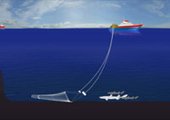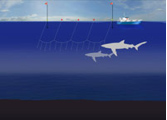The main fisheries of sharks

Don’t hesitate to ask where and how the fish you are going to buy were caught, either in the fish shop or in the restaurant. It may help if people are more conscious and feel more concerned about this question.
Coastal fishing: Trawlers with gillnets fishing on the bottom take rays and small coastal sharks like the spotted dogfish (Scyliorhinus sp.), the smooth hound (Mustelus sp.), the spiny dogfish (Squalus acanthias) and the school shark (Galeorhinus galeus).

Deep water fishing catches deep pelagic sharks such as the birdbeak dogfish (Deania calcea), the kitefin shark (Dalatias licha) or Portuguese dogfish (Centroscymnus coelolepis) using long lines, trawls and gillnets fishing on the bottom.

Deep-sea fishing catches big pelagic sharks, mainly the blue shark (Prionace glauca), the porbeagle shark (Lamna nasus) and the mako shark (Isurus oxyrinchus), especially with long lines on the surface.
Crocodile Epidemic in Kruger Park, South Africa
Some 170 crocodiles have been found dead since May, 2008 in the Krüger national park in South Africa, one of the largest animal reserves in Africa.
Scientists are working to contain the disease so that it does not propagate to other species.
The full grown reptiles whose size reaches several metres (up to 9m on rare occasions) do not have any natural predator.
However, these immense reptiles were victims of an infection called Pansteatitis which hardened the fat in their body like rubber, making them incapable of moving and leaving them defenseless to the elements, hunger, drowning or attack from other predators.
This disease is usually caused by the consumption of rancid or damaged fish.
The dead animals were discovered in a mud filled gorge, resulting from a nearby dam in Mozambique and fed by one of the most polluted rivers in South Africa - due to diverse heavy industries (mining, quarries and pesticide run-off from farms).
A research program was launched into the functioning of the river system to try to understand the cause of the epidemic.
The scientists are going to attempt to reproduce the disease in laboratory to understand how it propagates to crocodiles.
Since this report it has been impossible to find anymore internet information on the subject...
Reminder:
- Crocodiles are aquatic reptiles of the order of Crocodilia with 3 families, 8 genus and 23 species.
- Crocodilidae: 3 genus, 14 species (crocodiles)
Crocodiles live over a wide area of the tropics in Africa, Asia, Australia, and the Americas. They live mostly in rivers but the marine crocodile of Australia and of the islands of the Pacific ventures sometimes quite far offshore. Their head has a V form. - Alligatoridae (alligators and caïmans): 4 genus, 8 species
The Alligator genus consists of 2 species: The American alligator and the Chinese alligator (which is near to extinction). They have a wider, shorter and sharper head with a U form. When they close their jaw, the four teeth at bottom are not visible contrary to crocodiles, only the upper teeth are visible. - Caïmans (3 genus, 5 species) do not have any bone septum between nostrils. They can only be found in Central or Southern America.
- Gavialidae : 1 genus, 1 species
The gavial of the Ganges (Gavialis gangeticus) is one of the rarest species of crocodiles. You can find them in Nepal, Pakistan, Bangladesh and in India. The species is considered in danger of extinction.
- Crocodilidae: 3 genus, 14 species (crocodiles)













